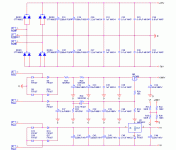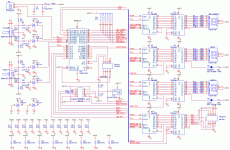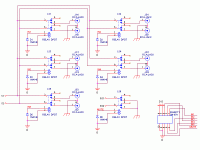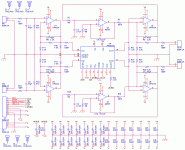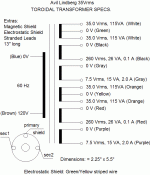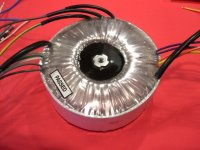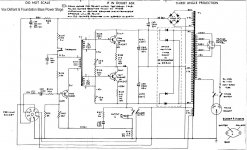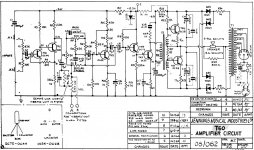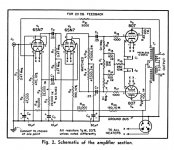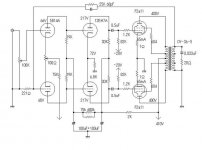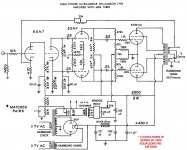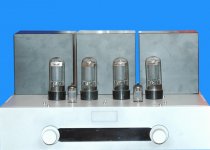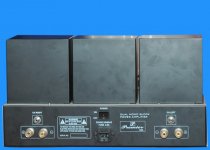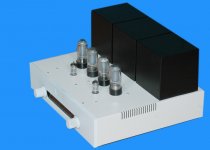As for the front panel:
You're sure you don't get any better than just blunt copying a Goldmund design?
You're sure you don't get any better than just blunt copying a Goldmund design?
With me, Goldmund is the optimal design should have nothing to change, even though I was capable of doing new things but it is not necessary.As for the front panel:
You're sure you don't get any better than just blunt copying a Goldmund design?
The difference in sound will be at the output circuit
Regrads.
It may be new for you, but in most parts of the world using other's intellectual property is theft, not a compliment.even though I was capable of doing new things but it is not necessary
Especially when someone is driven by commercial interests like you, as your website clearly states.
You too strictIt may be new for you, but in most parts of the world using other's intellectual property is theft, not a compliment.
Especially when someone is driven by commercial interests like you, as your website clearly states.
I Clone it,have not copied by my circuit is different with the original circuit,layout also so.
The clone a product, there are too many people have done.
it is very popular in the community diy audio, if the board banned, I will remove it now.
You too strict
I Clone it,have not copied by my circuit is different with the original circuit,layout also so.
The clone a product, there are too many people have done.
it is very popular in the community diy audio, if the board banned, I will remove it now.
Copying the Goldmund panel design particularly if you plan to sell this amplifier commercially is intellectual theft, and just because lots of other people do it does not make it right. Holger absolutely is right about this. Frankly IMHO it's also not a great look - be original and come up with something that captures the spirit of your design effort.
Copying the Goldmund panel design particularly if you plan to sell this amplifier commercially is intellectual theft, and just because lots of other people do it does not make it right. Holger absolutely is right about this. Frankly IMHO it's also not a great look - be original and come up with something that captures the spirit of your design effort.
The front panel looks similar but the circuit is completely different,not only that it is software of me wrote.
Regards.
Please boys.... a little bit more comprehension and understanding
No one is unique ... We always use knowledge handed down to us, assigned by someone else ... teachers had, the following examples, so all we do is because of something was done (adapted, created, or perfected or even developed) by someone else that worked on that before us.
We can not call a theft the investment in education of our parents made for our advantage .... but take it and do not pay or return , perhaps can be considered a robbery also ... after grow and earn money, based on the knowledge that we receive on account of money spent by our parents we have produced/earned some money .. should not we pay ..... give back to our parents?... and not giving... can be this be understood as a theft?
I think that creating an amplifier from scratch is something for super genius .... so, usually what people does is to created circuits and subcircuits that came into our head... and this started to belong to us...oru own brain library of knowledge.
This friend comes from a heroic people who endured much suffering, this people has faced with courage one of the strongest nation in earth in a time, and deserves respect .... and if you have lived the hystory you may know this very well.
Without arrogance this guy has been sharing his ideas ... and I do not he said this is entirely his creation .. imagine if someone can say something like that! ... learning from someone is what we have made .... we are not all that original .. we were instructed by someone .. this can be understood you have copied the knowledge of someone ... .. adapted from someone.
Even respectable guys alike Self and several important other names, had teachers...they born stupid knowing just to scream for food... and now a days...have they robbered something?... they have not born knowing what they know today.
I think some are getting heavy ... pushing hard... being a little rude to the man.... trying to give one on him... you should try to be more kind.
We are a product, a result of our age...of our period of time...now a days communication is easy and we know what people is doing all over the world...so...it is almost impossible to us to be original...... this could be possible if you land inside a spaceship, coming from other planet...people that is here, in earth, have inside their mind what others did.
regards,
Carlos
No one is unique ... We always use knowledge handed down to us, assigned by someone else ... teachers had, the following examples, so all we do is because of something was done (adapted, created, or perfected or even developed) by someone else that worked on that before us.
We can not call a theft the investment in education of our parents made for our advantage .... but take it and do not pay or return , perhaps can be considered a robbery also ... after grow and earn money, based on the knowledge that we receive on account of money spent by our parents we have produced/earned some money .. should not we pay ..... give back to our parents?... and not giving... can be this be understood as a theft?
I think that creating an amplifier from scratch is something for super genius .... so, usually what people does is to created circuits and subcircuits that came into our head... and this started to belong to us...oru own brain library of knowledge.
This friend comes from a heroic people who endured much suffering, this people has faced with courage one of the strongest nation in earth in a time, and deserves respect .... and if you have lived the hystory you may know this very well.
Without arrogance this guy has been sharing his ideas ... and I do not he said this is entirely his creation .. imagine if someone can say something like that! ... learning from someone is what we have made .... we are not all that original .. we were instructed by someone .. this can be understood you have copied the knowledge of someone ... .. adapted from someone.
Even respectable guys alike Self and several important other names, had teachers...they born stupid knowing just to scream for food... and now a days...have they robbered something?... they have not born knowing what they know today.
I think some are getting heavy ... pushing hard... being a little rude to the man.... trying to give one on him... you should try to be more kind.
We are a product, a result of our age...of our period of time...now a days communication is easy and we know what people is doing all over the world...so...it is almost impossible to us to be original...... this could be possible if you land inside a spaceship, coming from other planet...people that is here, in earth, have inside their mind what others did.
regards,
Carlos
Last edited:
another MosFet circuit
Hi
I have run through so many amps, I get confused.
The amp I worked on was a Mesa Boogie M-Pulse 600 bass amp. The customer brought it by for a bias adjust, and on the bench it blew up in front of us!
The solder work was very weak, and the MosFet connections were bad, so when I took my tiny screwdriver and tried to adjust the bias, the whole amp came apart.
I lost the circuit, or can't find the right folder. It looks very close to the SVT and your amp, would be good to have for reference. The input impedance of the output stage is exactly why I would use a 6FM8 as the power triode has a plate impedance of only 750 ohms, and ten watts of power.
I still think the driver transformer should be explored, will post some more "Stuff" to bug you guys.
I started this blog about my insane Tech adventures; Grid Leak
I have a lot more to post, including SS fun
gEo
Hi
I have run through so many amps, I get confused.
The amp I worked on was a Mesa Boogie M-Pulse 600 bass amp. The customer brought it by for a bias adjust, and on the bench it blew up in front of us!
The solder work was very weak, and the MosFet connections were bad, so when I took my tiny screwdriver and tried to adjust the bias, the whole amp came apart.
I lost the circuit, or can't find the right folder. It looks very close to the SVT and your amp, would be good to have for reference. The input impedance of the output stage is exactly why I would use a 6FM8 as the power triode has a plate impedance of only 750 ohms, and ten watts of power.
I still think the driver transformer should be explored, will post some more "Stuff" to bug you guys.
I started this blog about my insane Tech adventures; Grid Leak
I have a lot more to post, including SS fun
gEo
Hi
I have run through so many amps, I get confused.
The amp I worked on was a Mesa Boogie M-Pulse 600 bass amp. The customer brought it by for a bias adjust, and on the bench it blew up in front of us!
The solder work was very weak, and the MosFet connections were bad, so when I took my tiny screwdriver and tried to adjust the bias, the whole amp came apart.
I lost the circuit, or can't find the right folder. It looks very close to the SVT and your amp, would be good to have for reference. The input impedance of the output stage is exactly why I would use a 6FM8 as the power triode has a plate impedance of only 750 ohms, and ten watts of power.
I still think the driver transformer should be explored, will post some more "Stuff" to bug you guys.
I started this blog about my insane Tech adventures; Grid Leak
I have a lot more to post, including SS fun
gEo
Basically, my circuit has solved the problem: coordinate impedance, power, DC servo, ...
I see it quite optimization.
I will layout it soon.
Thank alot
Hi Everybody,
I'm selling ten transformers costume made by Avel Lindberg for a hybrid amp I designed a few years back that I think should work well for this project. The transformers have never been used. Below is a pic of the transformer, wiring diagram, and specs. PM or email me if you're interested.
Best Regards,
Al
I'm selling ten transformers costume made by Avel Lindberg for a hybrid amp I designed a few years back that I think should work well for this project. The transformers have never been used. Below is a pic of the transformer, wiring diagram, and specs. PM or email me if you're interested.
Best Regards,
Al
Attachments
Driver transformer to MOSfets
Hi
I feel the need to be a pest and put my four cents in
I am attaching two vintage 1960's Vox amp schematics showing the basic
driver transformer deal for transistors.
The usual is a two transistor stage driving a transformer with a split coil
secondary, with the biasing resistors hooked to those.
These amps were insanely stable, could take piles of overdrive, simple and had astounding endless bottom bass. I have had a pile of looney amps in the shop
the last four years, including a number of these SS amps.
I had a Fender SS Deluxe Reverb amp in, that had just acres of bass response, way more that most direct couple amps.
My blog, just started, GridLeak.blogspot.com
Now,
A. I have worked for companies that put those big sound systems together for big concerts, and have had lots of racks with stereo 150 to 1200 watt per
channel amps in the tech room.
I worked with a good friend, who has been in the business for ages, and had
his hands on acres of amps. A few years ago I helped him get some amp rack cases with Crest, QSC, and these big new Crown amps, crossovers etc. all together for sale.
I cobbled together several Crown 300 watt per channel amps, and he told me that these amps sucked for PA as even with the most insane driver circuit I
have ever seen, they had no clarity at power.
My friend has the experience of using various amps in concert systems, and
hearing what gear has good clarity, tone, and more.
He gave me a run down on what amps were very good for actual clear sound, and real flat response with smooth highs.
The Crest amps, 1200 watts per side MOSfet output stages, were the best
sounding amps in the racks we got ready.
I got a real live demonstration of how different circuit topologies give various tonal abilities in amps, including clarity.
B. So the big deal is that even if the output stage is very well designed, the
driver stage is most important, and no matter what you do CAD wise, software wise etc. how a amp actually works is hard to know.
The Crown folks spent a fortune designing a very complex amp to end up with crap, so how complex the driver stage is means little.
The best sounding, clarity, response, smooth highs SS amps I have used had
simple toplogies that just were the "Mgic" combination. I had a 60 watt per
channel Kenwood amp, that danced at 60V/sec slew, and sounded fantastic,
and a simple amp.
C. Using a driver transformer with MOSfets, could produce some very cool
amps. Combining the phas coherence of a driver transformer with a tube, (6FM7 , 6SN7 etc.) pre stage, and MOSfets for output, could make a super flat, stable amp, and should be tried.
I am sooper wanting to make a mike preamp, using a driver trans to give me push-pull out to 600 ohm loads with a small transformer. Then the expensive mike in transformer can be tossed and a interstage used to get balanced in.
D. The circuit being tossed around here, and hien.t.nguyen, circuit, is depending on that one cap connecting all the super fast bursts of complex harmonics from the driver stage to the MOSfets. How well this cap can do this is, to me highly questionable.
I would use the Williamson two tube driver stage, as it's drive impedance super low, lots of voltage out, and you can trim the balance level and frequency curve to the MOSfets.
While most music content is mosdestly steady energy, bursts of complex
harmonics from various instruments can demand lots more power at high slew rates. The driver stage should be able to deliver fast transients at levels much higher than the MOSfets, tubes or transistors can handle, so it remains stable.
So how much super fast transients that one cap can transfer?
I always play music through amps under test, and both the SVT and Mesa Boogie Mosfet amps, using the same driver topology sounded pretty good, but able to produce great Sax solos??
When I have the chance, I am going to build some transformer driven MOSfet
gear, and I will show what I come up with.
Hi
I feel the need to be a pest and put my four cents in
I am attaching two vintage 1960's Vox amp schematics showing the basic
driver transformer deal for transistors.
The usual is a two transistor stage driving a transformer with a split coil
secondary, with the biasing resistors hooked to those.
These amps were insanely stable, could take piles of overdrive, simple and had astounding endless bottom bass. I have had a pile of looney amps in the shop
the last four years, including a number of these SS amps.
I had a Fender SS Deluxe Reverb amp in, that had just acres of bass response, way more that most direct couple amps.
My blog, just started, GridLeak.blogspot.com
Now,
A. I have worked for companies that put those big sound systems together for big concerts, and have had lots of racks with stereo 150 to 1200 watt per
channel amps in the tech room.
I worked with a good friend, who has been in the business for ages, and had
his hands on acres of amps. A few years ago I helped him get some amp rack cases with Crest, QSC, and these big new Crown amps, crossovers etc. all together for sale.
I cobbled together several Crown 300 watt per channel amps, and he told me that these amps sucked for PA as even with the most insane driver circuit I
have ever seen, they had no clarity at power.
My friend has the experience of using various amps in concert systems, and
hearing what gear has good clarity, tone, and more.
He gave me a run down on what amps were very good for actual clear sound, and real flat response with smooth highs.
The Crest amps, 1200 watts per side MOSfet output stages, were the best
sounding amps in the racks we got ready.
I got a real live demonstration of how different circuit topologies give various tonal abilities in amps, including clarity.
B. So the big deal is that even if the output stage is very well designed, the
driver stage is most important, and no matter what you do CAD wise, software wise etc. how a amp actually works is hard to know.
The Crown folks spent a fortune designing a very complex amp to end up with crap, so how complex the driver stage is means little.
The best sounding, clarity, response, smooth highs SS amps I have used had
simple toplogies that just were the "Mgic" combination. I had a 60 watt per
channel Kenwood amp, that danced at 60V/sec slew, and sounded fantastic,
and a simple amp.
C. Using a driver transformer with MOSfets, could produce some very cool
amps. Combining the phas coherence of a driver transformer with a tube, (6FM7 , 6SN7 etc.) pre stage, and MOSfets for output, could make a super flat, stable amp, and should be tried.
I am sooper wanting to make a mike preamp, using a driver trans to give me push-pull out to 600 ohm loads with a small transformer. Then the expensive mike in transformer can be tossed and a interstage used to get balanced in.
D. The circuit being tossed around here, and hien.t.nguyen, circuit, is depending on that one cap connecting all the super fast bursts of complex harmonics from the driver stage to the MOSfets. How well this cap can do this is, to me highly questionable.
I would use the Williamson two tube driver stage, as it's drive impedance super low, lots of voltage out, and you can trim the balance level and frequency curve to the MOSfets.
While most music content is mosdestly steady energy, bursts of complex
harmonics from various instruments can demand lots more power at high slew rates. The driver stage should be able to deliver fast transients at levels much higher than the MOSfets, tubes or transistors can handle, so it remains stable.
So how much super fast transients that one cap can transfer?
I always play music through amps under test, and both the SVT and Mesa Boogie Mosfet amps, using the same driver topology sounded pretty good, but able to produce great Sax solos??
When I have the chance, I am going to build some transformer driven MOSfet
gear, and I will show what I come up with.
Attachments
Thank for your commentsHi
I feel the need to be a pest and put my four cents in
I am attaching two vintage 1960's Vox amp schematics showing the basic
driver transformer deal for transistors.
The usual is a two transistor stage driving a transformer with a split coil
secondary, with the biasing resistors hooked to those.
These amps were insanely stable, could take piles of overdrive, simple and had astounding endless bottom bass. I have had a pile of looney amps in the shop
the last four years, including a number of these SS amps.
I had a Fender SS Deluxe Reverb amp in, that had just acres of bass response, way more that most direct couple amps.
My blog, just started, GridLeak.blogspot.com
Now,
A. I have worked for companies that put those big sound systems together for big concerts, and have had lots of racks with stereo 150 to 1200 watt per
channel amps in the tech room.
I worked with a good friend, who has been in the business for ages, and had
his hands on acres of amps. A few years ago I helped him get some amp rack cases with Crest, QSC, and these big new Crown amps, crossovers etc. all together for sale.
I cobbled together several Crown 300 watt per channel amps, and he told me that these amps sucked for PA as even with the most insane driver circuit I
have ever seen, they had no clarity at power.
My friend has the experience of using various amps in concert systems, and
hearing what gear has good clarity, tone, and more.
He gave me a run down on what amps were very good for actual clear sound, and real flat response with smooth highs.
The Crest amps, 1200 watts per side MOSfet output stages, were the best
sounding amps in the racks we got ready.
I got a real live demonstration of how different circuit topologies give various tonal abilities in amps, including clarity.
B. So the big deal is that even if the output stage is very well designed, the
driver stage is most important, and no matter what you do CAD wise, software wise etc. how a amp actually works is hard to know.
The Crown folks spent a fortune designing a very complex amp to end up with crap, so how complex the driver stage is means little.
The best sounding, clarity, response, smooth highs SS amps I have used had
simple toplogies that just were the "Mgic" combination. I had a 60 watt per
channel Kenwood amp, that danced at 60V/sec slew, and sounded fantastic,
and a simple amp.
C. Using a driver transformer with MOSfets, could produce some very cool
amps. Combining the phas coherence of a driver transformer with a tube, (6FM7 , 6SN7 etc.) pre stage, and MOSfets for output, could make a super flat, stable amp, and should be tried.
I am sooper wanting to make a mike preamp, using a driver trans to give me push-pull out to 600 ohm loads with a small transformer. Then the expensive mike in transformer can be tossed and a interstage used to get balanced in.
D. The circuit being tossed around here, and hien.t.nguyen, circuit, is depending on that one cap connecting all the super fast bursts of complex harmonics from the driver stage to the MOSfets. How well this cap can do this is, to me highly questionable.
I would use the Williamson two tube driver stage, as it's drive impedance super low, lots of voltage out, and you can trim the balance level and frequency curve to the MOSfets.
While most music content is mosdestly steady energy, bursts of complex
harmonics from various instruments can demand lots more power at high slew rates. The driver stage should be able to deliver fast transients at levels much higher than the MOSfets, tubes or transistors can handle, so it remains stable.
So how much super fast transients that one cap can transfer?
I always play music through amps under test, and both the SVT and Mesa Boogie Mosfet amps, using the same driver topology sounded pretty good, but able to produce great Sax solos??
When I have the chance, I am going to build some transformer driven MOSfet
gear, and I will show what I come up with.
I am layout this project not yet.
You're right
Driver using transformer is one way to solve all technical problems of hybrid circuit
It combines impedence very good,provide enough current to drive the mosfets
But it is difficult to have good driver transformers in terms of DIY
If buy,it is also very expensive.
It is cumbersome,inconsistent with the PCB should be small.
Regrads,
All tube MOSfet push pull driver
Yeah, size is a major deal
I like great big amps, but need big room!
Using the two tube williamson style driver stage, you can use different transductance, current gain tubes to match up the drive parameters to the MOSfets??
Use a high gain, low power tube as phase splitter, then high current, low impedance as buffer
McIntosh complex driver stages use three different range tubes, from 12ax7 to 12au7, low gain high current, to match to output devices.
I designed my transistor mike preamps with a balanced in pre stage so they can run transformerless, as you are right, very expensive.
I built a lot of gear using my collection of Vintage iron, now all gone.
gEo
Yeah, size is a major deal
I like great big amps, but need big room!
Using the two tube williamson style driver stage, you can use different transductance, current gain tubes to match up the drive parameters to the MOSfets??
Use a high gain, low power tube as phase splitter, then high current, low impedance as buffer
McIntosh complex driver stages use three different range tubes, from 12ax7 to 12au7, low gain high current, to match to output devices.
I designed my transistor mike preamps with a balanced in pre stage so they can run transformerless, as you are right, very expensive.
I built a lot of gear using my collection of Vintage iron, now all gone.
gEo
Attachments
Yeah, size is a major deal
I like great big amps, but need big room!
Using the two tube williamson style driver stage, you can use different transductance, current gain tubes to match up the drive parameters to the MOSfets??
Use a high gain, low power tube as phase splitter, then high current, low impedance as buffer
McIntosh complex driver stages use three different range tubes, from 12ax7 to 12au7, low gain high current, to match to output devices.
I designed my transistor mike preamps with a balanced in pre stage so they can run transformerless, as you are right, very expensive.
I built a lot of gear using my collection of Vintage iron, now all gone.
gEo
Yes,I also like vintage
I have one tube amplifier with circuit from Dynaco,6AN8 + EL34/6P3c/...
Here
Attachments
- Status
- This old topic is closed. If you want to reopen this topic, contact a moderator using the "Report Post" button.
- Home
- Amplifiers
- Solid State
- New Project - Hybrid Amplifier High Quality
